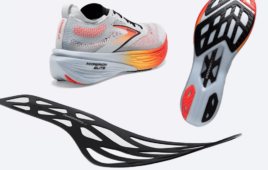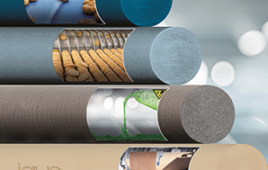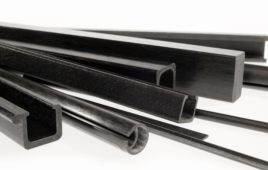Ribbons of ultrathin graphene combined with polyurethane paint meant for cars is just right for deicing sensitive military radar domes, according to scientists at Rice University.
The Rice lab of chemist James Tour, in collaboration with Lockheed Martin, developed the compound to protect marine and airborne radars with a robust coating that is also transparent to radio frequencies.
The research was published this week in the American Chemical Society journal Applied Materials and Interfaces.
Bulky radar domes (known as “radomes”) like those seen on military ships keep ice and freezing rain from forming directly on antennas. But the domes themselves must also be kept clear of ice that could damage them or make them unstable. This task is usually accomplished with a metal framework that supports and heats ceramic alumina (aluminum oxide), Tour said. But these materials are heavy, and metallic elements must be installed far from the source of radio signals to keep from interfering.
“It’s very hard to deice these alumina domes,” Tour said. “It takes a lot of power to heat them when they’re coated with ice because they’re very poor conductors.”
Enter graphene, the single-atom-thick sheet of carbon that both conducts electricity and, because it’s so thin, allows radio frequencies to pass unhindered. Spray-on deicing material that incorporates graphene nanoribbons would be lighter, cheaper and more effective than current methods, Tour said.
“This started when (Lockheed Martin engineer) Vladimir Volman saw a presentation by Yu Zhu, a postdoc in my lab at the time,” he said. “Volman had calculated that one could pass a current through a graphene film less than 100 nanometers thick and get resistive heating that would be great for deicing. Zhu was presenting his technique for spraying nanoribbons films and Volman recognized the potential.”
Pristine graphene transmits electricity ballistically and would not produce enough heat to melt ice or keep it from forming, but graphene nanoribbons (GNRs) unzipped from multiwalled carbon nanotubes in a chemical process invented by the Tour group in 2009 do the job nicely, he said. When evenly dispersed on a solid object, the ribbons overlap and electrons pass from one to the next with just enough resistance to produce heat as a byproduct. The effect can be tuned based on the thickness of the coating, Tour said.
In initial experiments, the team led by Volman and Zhu spray-coated a surface with soluble GNRs. “They said it works great, but it comes off on our fingers when we touch it,” Tour said.
He found the solution in a Houston auto parts store. “I bought some polyurethane car paint, which is extremely robust. On a car, it lasts for years. So when we combined the paint and GNRs and coated our samples, it had all the properties we needed.”
Lab samples up to two square feet were assembled using a flexible polymer substrate, polyimide, which was spray-coated with polyurethane paint and allowed to dry. The coated substrate was then put on a hotplate to soften the paint, and a thin GNR coat was airbrushed on. When dried, the embedded ribbons became impossible to remove. Tour said the researchers have also tried putting GNRs under the polyurethane paint with good results.
The 100-nanometer layer of GNRs — thousands of times thinner than a human hair — was hooked to platinum electrodes. Using voltage common to shipboard systems, the compound was sufficient to deice lab samples cooled to -4 degrees Fahrenheit within minutes. Further experiments found them to be nearly invisible to radio frequencies.
Tour said the availability of nanoribbons is no longer an issue now that they’re being produced in industrial quantities.
“Now we’re going to the next level,” he said, noting that GNR films made into transparent films might be useful for deicing car windshields, a project the lab intends to pursue.
Volman suggested the material would make a compelling competitor to recently touted nanotube-based aerogels for deicing airplanes in the winter. “We have the technology; we have the material,” he said. “It’s very durable and can be sprayed on to heat any kind of surface.”
Co-authors of the paper include Rice graduate students Abdul-Rahman Raji and Changsheng Xiang; Wei Lu and Carter Kittrell, research scientists at Rice’s Richard E. Smalley Institute for Nanoscale Science and Technology; and Bostjan Genorio, a former postdoctoral researcher at Rice, now a visiting scientist at Argonne National Laboratory. Tour is the T.T. and W.F. Chao Chair in Chemistry as well as a professor of mechanical engineering and materials science and of computer science.
The Lockheed Martin Corp. through the LANCER IV program, the Air Force Office of Scientific Research and the Office of Naval Research supported the research.
Filed Under: Materials • advanced




